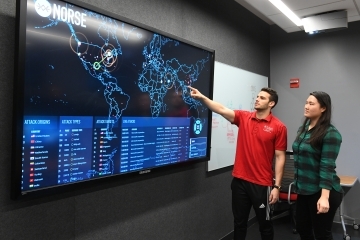The Impact of Cybersecurity

Imagine a world where all of your data—your personal, private, and sensitive data—was available
to anyone. No protection. No coverage. Now imagine that tenfold. Thousands of users’ data out
there for anyone to see.
That’s a world without cybersecurity. Cybersecurity protects all types of data against theft and deletion. It also keeps digital services and applications running. Without cybersecurity, many of your favorite apps and websites would be nearly impossible to run.
Developing Strong Cybersecurity Is Crucial
of organizations worldwide expected to have attacks on their software supply chains by 2025
Reduction in financial impact of individual security incidents by an organization adopting cybersecurity mesh
of corporate Board members classify cybersecurity as a business risk
As more of our world becomes interconnected through the IoT (Internet of Things), developing strong cybersecurity is more crucial than ever. Everything can be connected digitally, from lights to washing machines to cars and more. If cyber attackers get hold of that data and the devices using it, the implications are dire.
Take a look at cybersecurity even just decades ago—a virus could be placed on a floppy disk and replicated. Now, the attacks are more elaborate and complex so the methods to stop them must evolve accordingly. By applying rapidly evolving technologies such as artificial intelligence, machine learning, and behavioral detection, cybersecurity professionals can work to stop attacks before they start or put an end to them in minutes.
Technology Innovations in Cybersecurity
The Internet Crime Complaint Center (IC3) has averaged 652,000 complaints per year over the last five years. It’s likely you have been one of those 3.26 million complaints when you have received an alert of a compromised password or account. The attack surface available to hackers continues to expand as we create more data. Being able to quickly analyze data in order to minimize risk is becoming an increasingly impossible task—but the situation is expected to improve with the help of emerging technologies such as Artificial Intelligence (AI).
AI technology can quickly analyze millions of events happening at any given time and quickly identify the likelihood of an attack. And since these technologies learn more over time, they are able to adapt to new attack techniques to quickly detect possible cybersecurity risks by assessing normal behavior and discover outliers that are indicators of an attack.
Global artificial intelligence (AI) in cybersecurity market size evaluation in 2022
Expected compound growth rate of AI cybersecurity technologies through 2027
organizations spending more on AI and machine learning for cybersecurity
There are potential concerns with becoming so reliant on AI, however. This reliance may lead to a false sense of security, causing cybersecurity professionals to overlook potential concerns. Additionally, since so many of these assessments the AI is completing are done without human oversight, it may not be able to fully assess all the potential risks as a human being.
There is also the possibility that AI is misused and there are a number of ethical considerations with implementing this technology. AI is only as good as the data it receives, so it can learn to showcase bias or cause harm when used by people with malicious intentions.
The importance of ethical cybersecurity practices becomes paramount as technology advances. St. John’s University embraces these ethical considerations and promotes their importance throughout our curriculum.
Cybersecurity Laws and Regulations
Legislation around cybersecurity has struggled to keep pace with the continuing evolutions of cyberattacks. However, as the focus on digital security grows, more countries and regions are adapting new and updated cybersecurity regulations to try and protect businesses, people, and their data.
In the US, cybersecurity laws and regulations provide a framework for businesses and organizations on how to protect and secure their systems and networks. These regulations also ensure there’s a framework for holding businesses and entities accountable if they fail to protect the data they house—as well as giving victims some type of legal recourse if they are victim to cyber crime. There are several federal level entities that play a role in cybersecurity regulation.
- Department of Homeland Security (DHS)—protects the critical infrastructure of the United States such as power grids and financial systems
- Federal Bureau of Investigation (FBI)—FBI’s Cyber Division investigates cybercrime and espionage and partners with federal, state, and local authorities in these investigations as necessary
- Cybersecurity and Infrastructure Security Agency (CISA)—a subset of the DHS that protects US critical infrastructure and provides technical assistance and guidance to organizations to identify and mitigate potential threats
- National Institute of Standards and Technology (NIST)—conducts research and provides industry-standard measurements and reference materials to ensure accuracy and reliability of measurements
- Government Accountability Office (GAO)—conducts audits and investigations of federal agencies to assess compliance with cybersecurity regulations and operation efficiency
At St. John’s University, understanding these ever-changing regulations and entities at play is a core part of our curriculum. One of the main courses in the M.S. degree program in Cyber and Information Security is Cybersecurity Laws, Regulations, and Best Practices, which introduces these entities and how they interact and inform cybersecurity work.
Experts report the global existence of approximately 1.35 million tech startups with the expected number of smart devices collecting, analyzing, and sharing data reaching 50 billion by 2030, furthered by 500+ billion devices connected to the internet.
Overall, the world is projected to produce 463 exabytes of data by 2025 with more than 5 billion people connected to the internet. This rapid growth of technology innovation appears to outpace the international privacy and security regulations.
Pursuing an Advanced Degree in Cyber and Information Security
St. John’s innovative approach to cybersecurity and information security curriculum adapts to every student including their industry, field of interest, and unique needs. Even if you do not have a dedicated background in cybersecurity or IT, you can still pursue a master's degree in this growing field. St. John’s offers conditional acceptance upon completion of two prerequisite courses: CUS 620 Programming I and NET 510 Networks: Forms and Functions. Students in these courses benefit from learning from our esteemed faculty who are on the cutting-edge of research and technologies. Additionally, they establish a close relationship with each student to act as a mentor on their journey.
Specializations and Electives Offered from St. John’s University
The expansive curriculum covers a number of industries, fields, and technologies needed for a successful career in cybersecurity. The M.S. degree program requires all students to complete 30 credits according to the following degree requirement: core courses (12 credits), specialization (9 credits), elective course (3 credits), option of either capstone with additional elective (6 credits) or thesis (6 credits).






